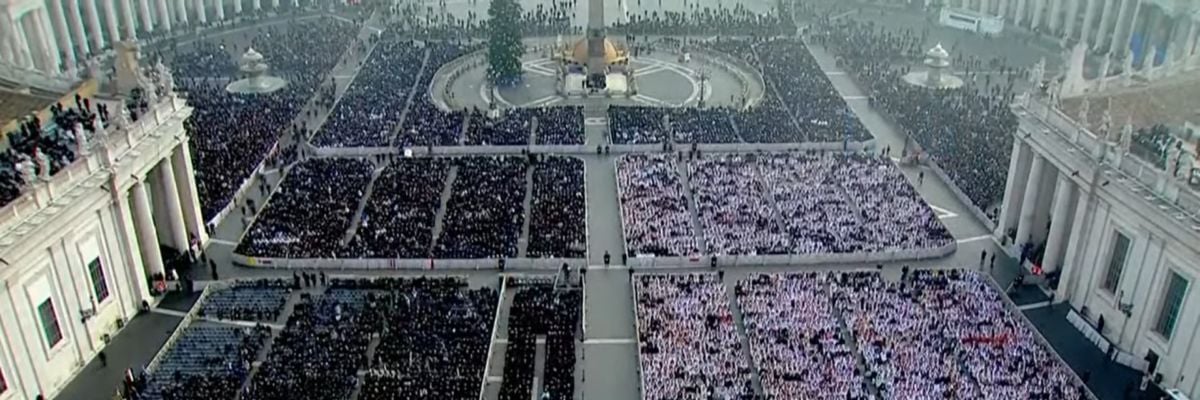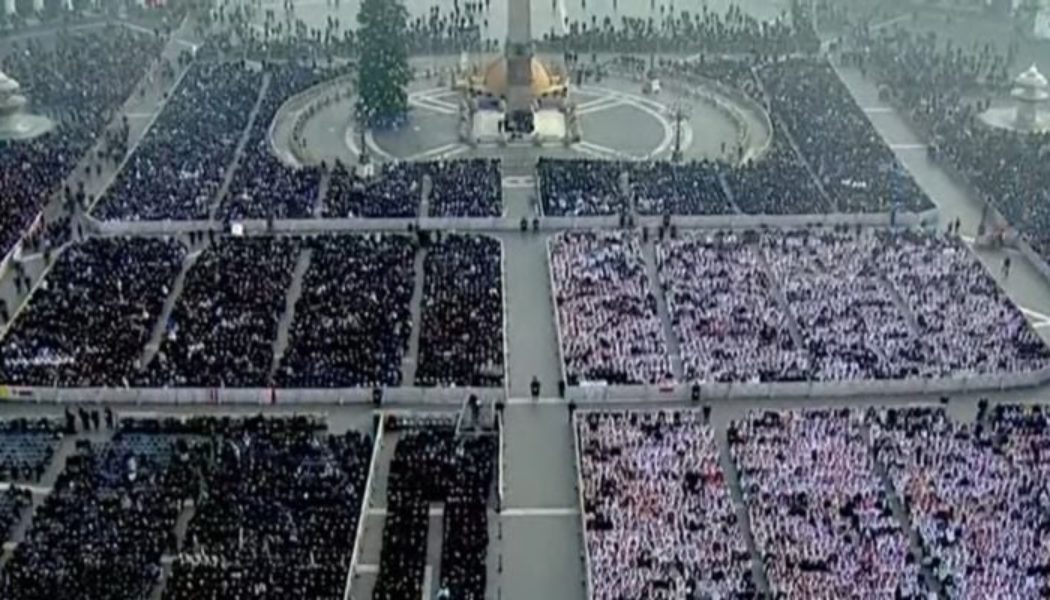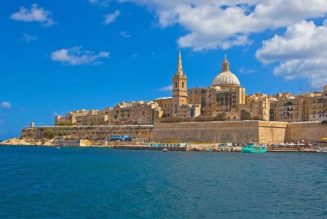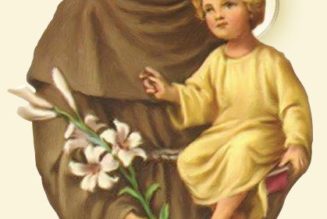
First, I will make a prediction. One day—within the next century—Benedict XVI will be declared a saint. Precisely how soon this will happen is uncertain, and it depends on whether the normal five-year waiting period is retained before his cause can be introduced. But it will happen.
This is a safe bet partly because it is the way of popes today. In prior centuries, popes may have shown their greatness much the way kings did—by building monuments and winning battles—but these days saintly popes are the fashion.
The shift is notable. Of the six nineteenth-century popes, one is a servant of God (Pius VII), and one is a blessed (Pius IX). None is a saint.
Of the eight twentieth-century popes, four are saints (Pius X, John XXIII, Paul VI, John Paul II), and one is venerable (Pius XII). Even John Paul I is a blessed, and he reigned only thirty-three days!
Given this trend, we would expect Benedict to be canonized, but we must add to this his personal holiness and one of the factors that will be on the mind of future popes when making the decision to canonize him: his resignation.
I was crushed when he resigned, and you can certainly argue that it was a mistake. However, medical technology has been extending people’s lifespans without comparably extending their “healthspans.” At the same time, telecommunication, travel, and the pace of life have picked up, so the demands made on a pope have increased. Without resignations, we could face the prospect of popes living for decades in a state of near incapacity.
I thus predict that papal resignations will become more common, and even normal, in the third millennium.
However painful Benedict’s resignation was, and whatever its immediate consequences, it was actually a gift to the Church, and some pope in this period of history needed to set the precedent.
Taking a historic view, by resigning, Benedict gave a lesson for future popes: they should resign if they no longer have the strength needed for the incredibly demanding office. They should make way for other men.
This requires humility, since the papacy is the capstone of an ecclesiastical career. The last pope to resign was Celestine V, who relinquished the office in 1294. After reigning only five months, he had no papal accomplishments besides recognizing that the Church would be better off with a different pope. He was recognized for his humility in resigning and canonized in just eighteen years. I am sure the same will happen for Benedict.
Benedict taught many more lessons, however, than the need to be willing to resign. He also left us a rich body of writings from both before and during his pontificate. It’s even possible that he had currently unreleased writings—perhaps penned during his retirement—that may one day be published.
One of the characteristics of Benedict’s writings is their clarity. He had a simpler, easier to comprehend style than John Paul II, which was one of the things I valued about his writings.
His humility also was on display in print. His position as the head of the Congregation for the Doctrine of the Faith required him to say no to erring theologians, which earned him disparaging nicknames such as “God’s Rottweiler” and Der Panzerkardinal, after the German tanks used in World War II. However, these nicknames did him a disservice. He may have been required by office to point out when ideas were incompatible with the teachings of the Faith, but he was actually very willing to engage with other points of view.
He also did not write the documents he signed as the head of the CDF. He wanted them to reflect more than just his own views—to be broadly Catholic—and so he had them written by assistants, lest he impose his personal theology on others.
The extent of his engagement with other points of view is further on display in the writings he personally penned. For example, in volume two of his Jesus of Nazareth series, he has an extended discussion of a theory proposed by French scholar Annie Jaubert, according to which the Last Supper took place on Holy Tuesday rather than Holy Thursday.
Although he is ultimately skeptical of this proposal, his engagement and serious consideration of a revision to the chronology of Holy Week are striking.
The passage also teaches an important lesson for when you are reading Ratzinger: keep reading! He has a habit of giving alternative views their full due before making his own assessment.
If you read isolated passages from his writings, you might mistakenly think he was advocating an idea, when what he actually was doing was stating the positive case for it before saying what he thought. Consequently, it’s important to keep reading Ratzinger to the end of his discussion of a topic.
Jesus of Nazareth is famous for a statement Benedict makes in the foreword to volume one. There he wrote,
It goes without saying that this book is in no way an exercise of the Magisterium, but is solely an expression of my personal search “for the face of the Lord” (cf. Ps. 27:8). Everyone is free, then, to contradict me. I would only ask my readers for that initial goodwill without which there can be no understanding.
For a pope to openly say that everyone is free to contradict him is another striking sign of humility.
It also illustrates that he has a clear awareness between what the Faith requires and what is open to discussion. The Faith requires that Christ “was crucified, died, and was buried.” But it does not require that the Last Supper was eaten on a Thursday, so that can be debated.
Because it focuses on the Gospels, Jesus of Nazareth illustrates how Benedict approached Scripture. He is famous for having called Scripture scholars back from the sterile, “scientific” skepticism that had infected much of twentieth-century Catholic scholarship.
For Benedict, the Scriptures must be read within the context of faith, and to try to consider them apart from the Faith is to fundamentally misread them, as they are addressed to the believing community. This does not mean simply repeating historical interpretations and opinions, but engaging with them creatively and intelligently.
And, based on various statements in the early Church Fathers, Benedict was open to ideas that have begun to have currency in modern scholarship. For example, although he believed that the Gospel of John was based on the memories of John the Apostle, he believed it was actually written by another figure mentioned in early Christian sources—John the Elder—whom he also regarded as the author of 2 and 3 John.
This retrieval of early Christian sources reflects the broader theological movement of which Joseph Ratzinger was a part. By the mid-twentieth century, many European theologians were concerned that theology had been fossilized in a neo-Scholastic, neo-Thomistic form, and they called for a return to the biblical and Patristic sources of faith.
This ressourcement, as it was called, was meant to allow a retrieval of Christian views that had been lost so that they might be reappropriated and creatively applied to the questions facing the Church in the twentieth century.
This included revisiting traditional ways of expressing the Faith and retaining their essential content but also considering how else they might be understood and expressed.
For example, is it necessary to think of purgatory as a kind of prison in which God actively punishes people? In his encyclical on Christian hope, Spe Salvi, Benedict XVI proposed the following:
Some recent theologians are of the opinion that the fire which both burns and saves is Christ himself, the Judge and Savior. The encounter with him is the decisive act of judgment. Before his gaze all falsehood melts away. . . . His gaze, the touch of his heart heals us through an undeniably painful transformation “as through fire.” But it is a blessed pain, in which the holy power of his love sears through us like a flame, enabling us to become totally ourselves and thus totally of God (47).
This is an extraordinary statement in that Benedict proposes this understanding of purgatory without imposing it as a matter of Church teaching.
That is a remarkable example of papal restraint and humility—not least because as Joseph Ratzinger, he was one of the theologians who proposed this understanding, having discussed it in a textbook he wrote on dogmatic theology called Eschatology: Death and Eternal Life.
Benedict XVI also was known for his efforts to heal divisions in the Christian community. As pope, he liberalized the celebration of the traditional Latin Mass and lifted the excommunications on the Lefebvrist bishops in an effort to heal the rift with the Society of St. Pius X.
He also created a way for Anglican priests and congregations to reunite with the Catholic Church through what are now known as the Anglican ordinariates.
And even before he was pope, he was closely involved with the Joint Declaration on the Doctrine of Justification, which was initially signed by the Catholic Church and the Lutheran World Federation (1999) and has since been joined by the World Methodist Council (2006) and the World Communion of Reformed Churches (2017).
As prefect of the CDF, Ratzinger halted the initial publication of the work because of problems it contained, but then he found a way to correct these and push the project forward. And so, in the Year of St. Paul that Benedict had announced, he stated,
Luther’s phrase: “faith alone” is true, if it is not opposed to faith in charity, in love. Faith is looking at Christ, entrusting oneself to Christ, being united to Christ, conformed to Christ, to his life. And the form, the life of Christ, is love; hence to believe is to conform to Christ and to enter into his love. So it is that in the letter to the Galatians in which he primarily developed his teaching on justification, St. Paul speaks of faith that works through love (cf. Gal. 5:14).
In assessing the career of Joseph Ratzinger—before, during, and after his papacy—we find a truly remarkable individual. He was passionate about the Catholic faith and the Church. He was keenly aware of the difference between what the faith requires and what can be debated.
He strove to engage the sources of the Faith and to articulate its teachings in a positive, compelling manner.
He was openminded and patient, and he enjoyed creative engagement with intellectual questions.
A profoundly humble man, he described himself as a “humble worker in the vineyard of the Lord.”
May he—and we all—hear these words: “Well done, good and faithful servant. You have been faithful over a little; I will set you over much. Enter into the joy of your master” (Matt. 25:23).
Image: Funeral of Pope Benedict XVI. Credit: Washington Post via YouTube, CC BY 3.0.








![Following UK Prime Minister Boris Johnson’s Catholic wedding, the task of announcing new Anglican bishops will fall to someone else [London Times paywall]…](https://salvationprosperity.net/wp-content/uploads/2021/06/following-uk-prime-minister-boris-johnsons-catholic-wedding-the-task-of-announcing-new-anglican-bishops-will-fall-to-someone-else-london-times-paywall-scaled-327x219.jpg)